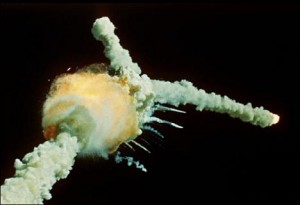Challenger Shuttle Disaster at 25
In the span of a week, NASA is observing its three darkest moments in spaceflight. Including today’s 25th anniversary of the space shuttle Challenger disaster.
Seven astronauts died January 28, 1986, when Challenger was destroyed just after liftoff. It was NASA’s first in-flight calamity, and it dealt an especially severe blow to the millions of teachers and students watching on TV to see Christa McAuliffe, a civilian high school teacher from New Hampshire, become NASA’s first Teacher in Space.
Former astronauts and the widow of Challenger STS-51L mission commander Francis ‘Dick’ Scobee will speak today (January 28) at a memorial service at NASA’s Kennedy Space Center Visitor Complex in Cape Canaveral, Fla.
That commemoration comes a day after the 44th anniversary of the Apollo 1 disaster, when three astronauts died in a fire that broke out inside their module during a ground test roughly a month before launch. And February 1 will be the eighth anniversary of the space shuttle Columbia accident, in which seven astronauts died when the shuttle broke up in the skies over Texas during the return from orbit.
Even before he could drive a car, Michael Smith wanted to fly.
The Beaufort native, who grew up a few miles down the road from a small local airport that now bears his name, qualified for his pilot’s license a few days before turning 16. Twenty-four years later, he was the pilot on the ill-fated Challenger space shuttle mission that killed all seven astronauts aboard.
Smith’s name still resonates 25 years later in the coastal town he called home – it’s on a memorial near the waterfront, on the airport where he learned to fly as a teenager and in a part of Beaufort Elementary School packed with exhibits about his life and the space program.
“So many people here in Beaufort knew Michael Smith” – said Vicki Fritz, principal of the school, which opened the Michael J. Smith Air and Space Mini-Museum last year on the 24th anniversary of the tragedy.
Inside, murals depict a midnight-blue night sky dotted with stars. Memorabilia ranges from a tire that was on the space shuttle that followed the Challenger to mementoes from a career that included a stint as a naval aviator in the Vietnam War.
http://www.youtube.com/watch?v=_10T4UYpzV8
On January 28, 1986, First Class Petty Officer Dennis Nelson stood on the bridge of the USS Aubrey Fitch about 50 miles southeast of Cape Canaveral. Little did he know that he would soon be a part of one of the biggest search efforts in history.
Two sailors looked up toward the sky.
“The Challenger is going to launch” – they told him.
Nelson, a career Navy man who had lived in Orlando, Fla., had seen shuttle launches before. They go straight up and disappear, he said.
Not this time.
“I saw the Challenger blow up” – he said. “Two fuel pods spiraled off.”
What he saw didn’t make sense to him, he said from his Visalia home Wednesday. Like the news photographs of people at Cape Canaveral looking up on that fateful day, he, too, did not immediately grasp what went wrong, he said.
The Challenger disintegrated over the Atlantic Ocean at 8:39 a.m.
In less than an hour, the Aubrey Fitch, a guided-missile frigate returning from the Bahamas, turned around to begin search-and-rescue operations for the Challenger shuttle.
It was the first ship on the scene, he said.
“We were expecting the worst” – he said. “We were expecting to find bodies.”
